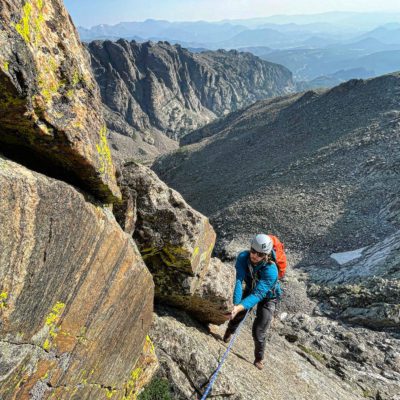How to Store your Backcountry Gear over the Summer
April 11, 2020 | Posted in: JHMG
With the rapid spread of COVID-19 shutting down national parks and ski areas alike, our ski season has come to an early end. With all of this free time on your hands, why not set your future self up for success by properly checking and storing your touring gear. These are things to consider when putting your backcountry gear away for the summer.
Skis
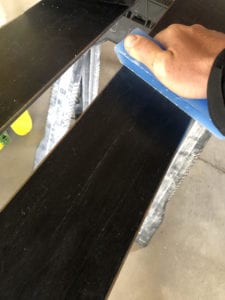 First, make sure that your skis are fully cleaned. Hose them off outside, wipe them down with a wet towel, spray them down in the shower, whatever works best for you. Over the past several months, your bases have been taking on dirt, skin glue and whatever other particles were in the snow. Getting all the gunk out of your bases, bindings and topsheets helps to lengthen the lifespan of your gear.
First, make sure that your skis are fully cleaned. Hose them off outside, wipe them down with a wet towel, spray them down in the shower, whatever works best for you. Over the past several months, your bases have been taking on dirt, skin glue and whatever other particles were in the snow. Getting all the gunk out of your bases, bindings and topsheets helps to lengthen the lifespan of your gear.
The bases of your skis are like the pores of your skin. It’s important to exfoliate them to keep them healthy, so once your skis are washed and completely dry, start prepping your bases by running a steel or copper brush along the base from tip to tail a few times. If you don’t have a waxing brush, then a Scottbrite pad will do the trick.
If you notice that the edges aren’t sharp enough to scrape off some of your fingernail or have nicks or dings in them, give them a quick tune. Then apply a healthy dose of storage wax to the bases of your boards.  Cover not just the bases, but also the edges. Adding storage wax keeps your bases from drying out and your edges from rusting over the summer. You can either follow the traditional waxing iron method, or use a heat gun to melt the side of the wax and rub it on.
Cover not just the bases, but also the edges. Adding storage wax keeps your bases from drying out and your edges from rusting over the summer. You can either follow the traditional waxing iron method, or use a heat gun to melt the side of the wax and rub it on.
If you don’t own any tuning or waxing gear, consider supporting your local economy and doing some research into which shops are still operating with drop off and pick up services. You can either pick up the needed equipment or hire the tech to do the work for you.
Finally, take a moment to check your bindings. Leave the bindings in ski mode, especially if you use brakes. If you run a tech-toe system, pop the lever up into ski mode to release tension from the springs. You can also release pressure from the binding system by turning down the release or DIN value. You don’t want to put it all the way to zero, but leaving it at a one or two lets your bindings relax over the summer.
Boots
We’ve all had that one pair of boots that we’re sure we’ll never be able to replace, so why not take care of them to make them last longer?
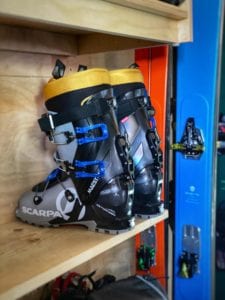 I like to use an old toothbrush to scrub out the toe and heel tech fittings of my boots, making sure to clear out any dirt that has built up over the season. Check the soles to make sure that there aren’t any rocks or dirt lingering in the tread. You could even go as far as to gently scrub the outside of the shell with a mild cleaning solution if you want to keep your boots looking fresh for longer. Avoid any solutions that use bleach or ammonia.
I like to use an old toothbrush to scrub out the toe and heel tech fittings of my boots, making sure to clear out any dirt that has built up over the season. Check the soles to make sure that there aren’t any rocks or dirt lingering in the tread. You could even go as far as to gently scrub the outside of the shell with a mild cleaning solution if you want to keep your boots looking fresh for longer. Avoid any solutions that use bleach or ammonia.
Buckles tend to loosen and wear out over time. Check each buckle individually to make sure that they’re clean and properly tightened. Most boots come with some sort of allen wrench that fits their screws that you can use for tightening. Once you’re certain that the liners are completely dry, leave the boots loosely buckled to help the shells hold their shape over the summer.
If you notice that your boots are giving off the tell tale stench of a backcountry skier, spray your liners with a disinfectant and throw an air freshener or a few dryer sheets inside to keep the stink away over the summer. Your ski partners will thank you.
Skins
Out of all of our backcountry equipment, the lifespan of a pair of skins can vary the most depending on the care you give them . First and foremost, do not store them on your skis over the summer. Not only will this destroy your bases, but it will also ruin the glue on your skins.
While you should consider storing all of your gear in a cool, dry place with no direct sunlight, your skins are the item that must be stored that way. Let them get too warm in the heat of the summer, and the glue will start to pearl and stick to your skis. Avoid leaving them in your laundry room or in a closet near any kind of heater. While I never carry skin savers into the backcountry, they can be helpful to keep the glue off the glue over the summer when the skins are folded. I personally put my skins back in the bag that they came in for storage and leave them on a low, shaded shelf in the corner of my garage.
Beacon
Before putting your beacon away for the summer, take a moment to make sure there are no cracks on the body of your beacon and the screen is reading properly. 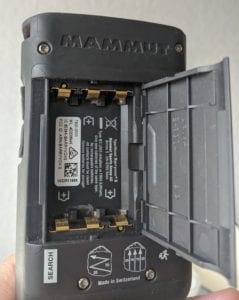 Do some research on your beacon model and see if there are any available software updates. Some beacon manufacturers have you send them in, while others offer updates at your local gear shop. Summer is the perfect time to make sure that your beacon is fully up to date.
Do some research on your beacon model and see if there are any available software updates. Some beacon manufacturers have you send them in, while others offer updates at your local gear shop. Summer is the perfect time to make sure that your beacon is fully up to date.
Check the battery percentage on your beacon. If it’s less than fifty percent, throw the batteries into your headlamp or your TV remote. If they still have enough power for next year, I’ll tape them to the outside of my beacon as a reminder for next season.
The cardinal sin of backcountry gear storage is leaving your batteries in your beacon. Ever opened up your headlamp to find a white coating of battery acid all over the nodes? Don’t let that happen to your beacon. That could ruin this incredibly important piece of safety equipment. Wipe away away residue near the terminals with a cloth rag to prevent further corrosion.
Shovel and Probe
While your shovel and probe don’t necessarily need any special storage treatment, I always like to give my gear a once over at the end of the season.
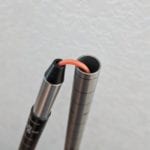 On your shovel, check to make sure that the edge of the blade isn’t getting worn down and clean any lingering dirt. Pull the whole thing apart to make sure that all of the pieces are sliding properly. Double check the pins that keep the handle in place to see if any of them are crooked or getting stuck.
On your shovel, check to make sure that the edge of the blade isn’t getting worn down and clean any lingering dirt. Pull the whole thing apart to make sure that all of the pieces are sliding properly. Double check the pins that keep the handle in place to see if any of them are crooked or getting stuck.
The wires and the joints of your probe are the things that will generally break first. While the probe is broken down and folded up, check either end to make sure that there is no cracking around the edges of the joints and that the wire isn’t fraying. If you notice either of those things, then add a probe to next year’s Autumn shopping list.
About the Author
 Betsy Manero started skiing in Maine and New Hampshire at a young age and has been hooked on the mountains ever since. She started climbing in Vermont during college and moved to the Tetons in 2015 to pursue bigger mountains. When not guiding for JHMG Betsy can be found skiing touring or climbing in Grand Teton National park or exploring sandstone formations of Southern Utah.
Betsy Manero started skiing in Maine and New Hampshire at a young age and has been hooked on the mountains ever since. She started climbing in Vermont during college and moved to the Tetons in 2015 to pursue bigger mountains. When not guiding for JHMG Betsy can be found skiing touring or climbing in Grand Teton National park or exploring sandstone formations of Southern Utah.

